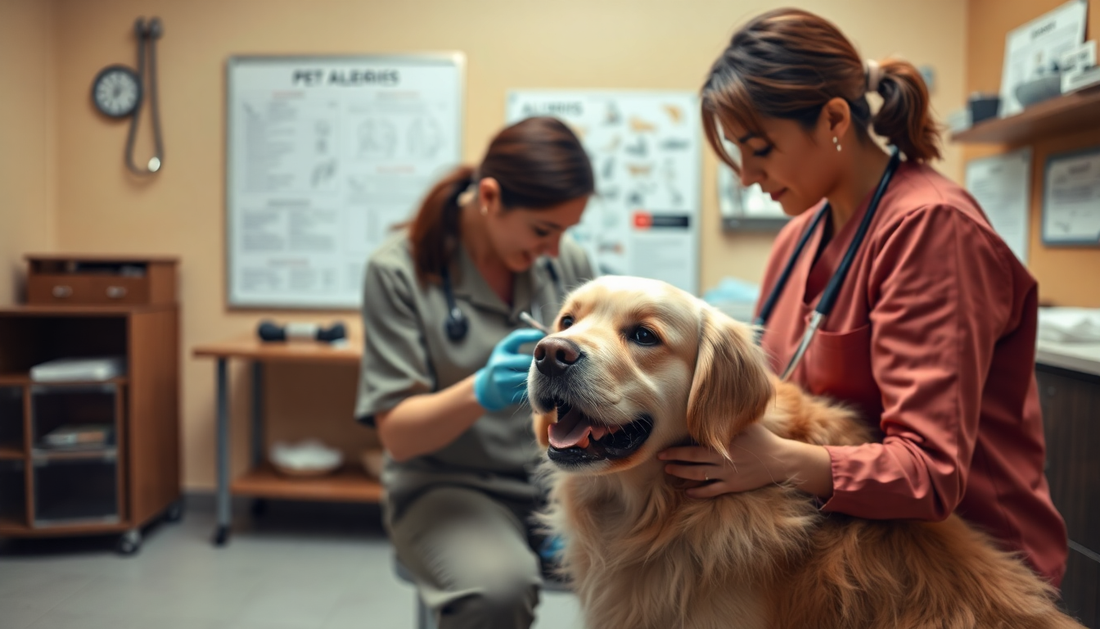
How to Spot Allergies in Pets: A Guide from the Furry Buddy Club
Share
As pet owners, we want nothing more than to ensure the health and happiness of our furry companions. One common issue that can impact our pets' well-being is allergies. Whether it's food, environmental, or seasonal allergies, recognizing the signs and taking the right steps to manage them is crucial for your pet's comfort and long-term care.
At the Furry Buddy Club, we've seen firsthand the challenges pet owners face when it comes to identifying and addressing allergies. That's why we've put together this comprehensive guide to help you navigate the world of pet allergies and provide your beloved animal with the relief they deserve.
Types of Pet Allergies
Allergies in pets can manifest in various forms, and it's important to understand the different types to better identify and address the underlying issue.
Food Allergies
Food allergies are one of the most common types of allergies in pets. These occur when your pet's immune system overreacts to certain proteins in their diet, leading to a range of symptoms. Common culprits include beef, dairy, chicken, and wheat.
Environmental Allergies
Environmental allergies are triggered by substances in your pet's surroundings, such as pollen, dust mites, or even certain materials. These can cause skin irritation, respiratory issues, and other discomforts.
Seasonal Allergies
Seasonal allergies are a type of environmental allergy that flare up during specific times of the year, often in response to changes in pollen levels or other environmental factors.
Flea Allergy Dermatitis
Flea allergy dermatitis is a condition where pets have an exaggerated immune response to flea saliva, leading to severe skin irritation and itching.
Common Allergy Symptoms
Recognizing the signs of allergies in your pet is the first step in providing them with the necessary care. Some of the most common allergy symptoms include:
- Skin irritation and itching
- Excessive paw licking
- Ear infections
- Digestive issues, such as vomiting or diarrhea
If you notice your pet exhibiting any of these symptoms, it's important to consult with your veterinarian to determine the underlying cause and develop an appropriate treatment plan.
Diagnostic Approaches
Identifying the specific allergen causing your pet's discomfort is crucial for effective management. Your veterinarian may recommend the following diagnostic approaches:
Veterinary Consultation
A thorough examination by a veterinarian can help rule out other potential health issues and provide guidance on the next steps in the diagnostic process.
Allergy Testing
Allergy testing, such as intradermal or blood tests, can help identify the specific allergens your pet is reacting to, allowing for more targeted treatment.
Elimination Diets
An elimination diet, where your pet is fed a limited-ingredient diet for a period of time, can help determine if food allergies are the root cause of the problem.
Management Strategies
Once the underlying allergy has been identified, there are several strategies you can implement to help manage your pet's symptoms and improve their overall well-being.
Limited Ingredient Diets
Switching to a limited-ingredient diet that avoids the identified allergen can help alleviate digestive issues and skin irritation.
Hypoallergenic Products
Using hypoallergenic shampoos, conditioners, and other grooming products can help reduce exposure to potential allergens and soothe your pet's skin.
Home Environment Modifications
Making changes to your home environment, such as using air purifiers, vacuuming regularly, and limiting exposure to dust and pollen, can help minimize your pet's contact with environmental allergens.
Nutritional Supplements
Supplements containing omega-3 fatty acids and probiotics can help support your pet's skin health and immune system, aiding in the management of allergies.
Prevention and Long-Term Care
In addition to managing your pet's allergy symptoms, there are steps you can take to prevent and maintain long-term control over their allergies.
Regular Grooming
Consistent grooming, including regular baths and brushing, can help remove allergens from your pet's coat and skin, reducing the risk of flare-ups.
Omega-3 and Probiotic Supplementation
Incorporating omega-3 fatty acids and probiotics into your pet's diet can help strengthen their immune system and promote overall skin health.
Reducing Allergen Exposure
Monitoring and minimizing your pet's exposure to known allergens, whether it's certain foods, environmental triggers, or flea infestations, can go a long way in preventing and managing their allergies.
Monitoring and Tracking Symptoms
Keeping a close eye on your pet's symptoms and maintaining detailed records can help you and your veterinarian identify patterns and adjust the management plan as needed.
Conclusion
Navigating the world of pet allergies can be a daunting task, but with the right knowledge and proactive approach, you can help your furry companion find relief and enjoy a happy, healthy life. By understanding the different types of allergies, recognizing the symptoms, and implementing effective management strategies, you can take control of your pet's well-being and provide them with the care they deserve.
At the Furry Buddy Club, we're committed to empowering pet owners with the information and resources they need to ensure the best possible quality of life for their beloved animals. If you have any further questions or concerns about your pet's allergies, don't hesitate to reach out to our team of experts. Together, we'll work to keep your Furry Buddy happy, healthy, and thriving.
